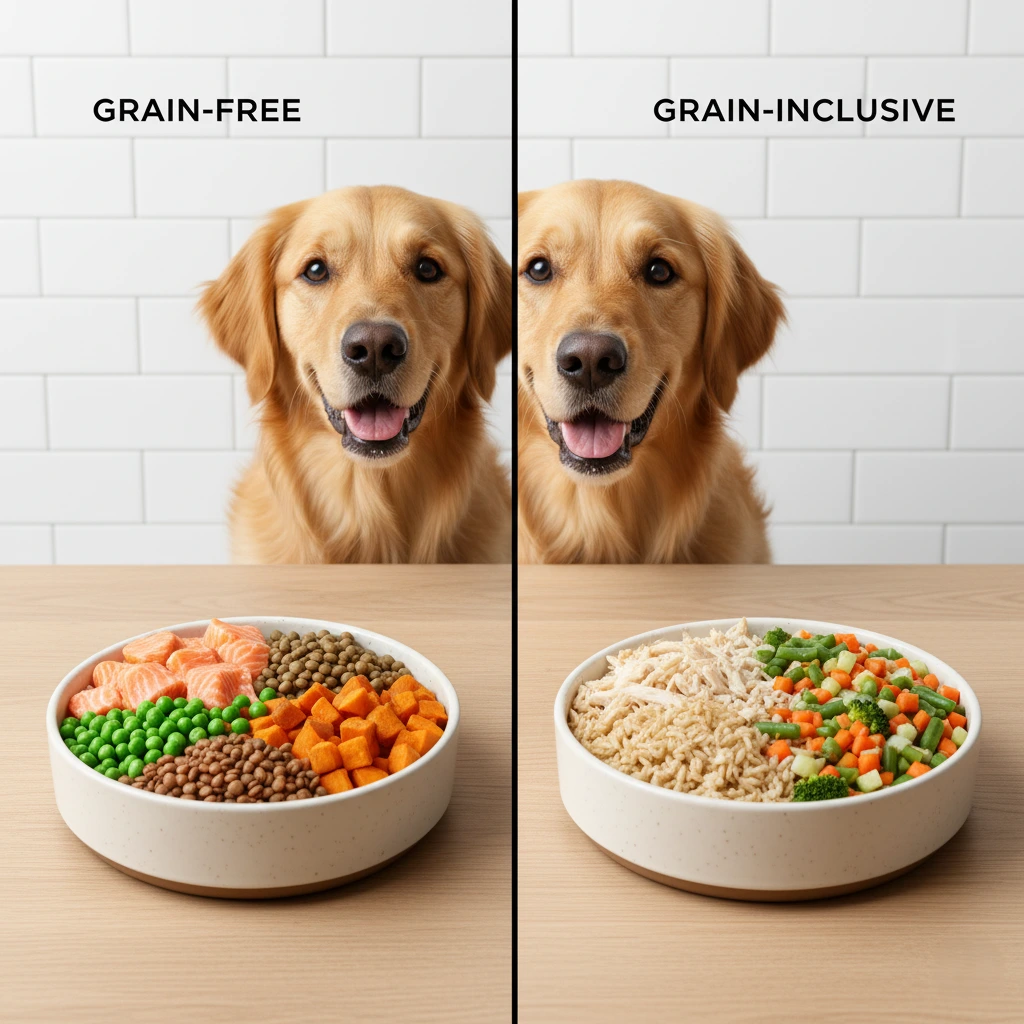Understanding the Debate Around Dog Diets
In recent years, the pet food industry has been divided over one major question: should dogs eat grains? The debate between grain-free and grain-inclusive diets has become one of the hottest topics among veterinarians, pet nutritionists, and dog parents. On one side, grain-free advocates argue that dogs are descendants of wolves and therefore thrive on meat-heavy diets. On the other, supporters of grain-inclusive formulas emphasize the importance of whole grains for digestive health and sustained energy. With so much conflicting information online, it can be challenging to decide which diet is right for your furry companion.
What Are Grain-Free Dog Diets?
A grain-free dog diet eliminates common grains such as wheat, corn, barley, rice, and oats. Instead, these foods are replaced with alternative carbohydrate sources like sweet potatoes, lentils, peas, or chickpeas. The grain-free movement gained popularity as more dogs began showing symptoms of food allergies or sensitivities. Pet owners noticed improvements in digestion, coat condition, and energy when switching to grain-free formulas. Additionally, many grain-free brands highlight high-protein, low-carb recipes, appealing to those who believe in a more “ancestral” or biologically appropriate diet for dogs.
What Are Grain-Inclusive Dog Diets?
Grain-inclusive diets contain wholesome grains that provide fiber, vitamins, and minerals. Common examples include brown rice, oatmeal, barley, quinoa, and whole wheat. These ingredients are not just fillers—they offer essential nutrients that contribute to gut health, energy regulation, and cardiovascular function. Dogs have evolved alongside humans for thousands of years, developing enzymes that help digest grains efficiently. As a result, well-balanced grain-inclusive formulas can support long-term health by providing both protein and complex carbohydrates.
The Nutritional Role of Grains in Dog Food
Grains are often misunderstood in dog nutrition. While low-quality pet foods may use refined grains or corn gluten as cheap fillers, whole grains are a valuable source of energy and nutrients. They contain B vitamins, iron, magnesium, and dietary fiber, which promote healthy digestion and metabolism. Fiber helps regulate bowel movements, while complex carbs provide sustained energy throughout the day. Dogs that lead active lifestyles—like working breeds or high-energy pups—may benefit from these slow-release carbohydrates. However, dogs with allergies to specific grains might need alternatives to prevent irritation or inflammation.
The Grain-Free Trend: Benefits and Concerns
Grain-free diets initially gained popularity as a solution for dogs with itchy skin, gastrointestinal upset, or food sensitivities. Many owners reported noticeable improvements after making the switch. These diets often use premium protein sources like salmon, duck, or bison, which can be gentler on sensitive stomachs. They’re also free from gluten, making them suitable for dogs with celiac-like reactions. However, recent studies raised concerns linking some grain-free diets—especially those high in legumes—to canine dilated cardiomyopathy (DCM), a heart condition associated with nutrient imbalances. While research is still ongoing, veterinarians recommend caution and label awareness when choosing grain-free foods.
How to Identify a Quality Grain-Inclusive Food
If you prefer a grain-inclusive diet, quality should always come first. Look for whole grains instead of refined ones, and avoid foods where corn or wheat appear as the main ingredients. Premium grain-inclusive dog foods often combine lean proteins (like chicken, lamb, or fish) with brown rice or barley to create a balanced, nutrient-dense meal. Avoid artificial additives, colors, and preservatives, which can trigger allergies or digestive issues. Many reputable brands now offer holistic or natural grain-inclusive formulas, providing the best of both worlds—nutrient diversity and high-quality sourcing.
How to Identify a Quality Grain-Free Food
Not all grain-free foods are created equal. When selecting a grain-free formula, ensure that animal protein is the first ingredient, not peas or lentils. The protein content should be high enough to meet your dog’s activity level, while carbohydrates should remain moderate. Look for foods fortified with taurine, L-carnitine, and omega fatty acids to support heart and skin health. Grain-free doesn’t always mean carb-free, so avoid brands that overload on starchy vegetables or legumes. The best grain-free foods prioritize balanced nutrition and ingredient transparency.
Common Myths About Grains and Dogs
One of the biggest misconceptions is that dogs cannot digest grains because their ancestors didn’t eat them. However, domestication has allowed dogs to adapt to a more omnivorous diet. Another myth is that grains automatically cause allergies. In reality, animal proteins like beef, chicken, and dairy are more likely to trigger food sensitivities. Grains are rarely the culprit, and completely removing them without reason could lead to nutrient gaps. Understanding the difference between cheap fillers and nutrient-rich grains is key to making a smart dietary choice for your dog.
Considering Your Dog’s Lifestyle and Health
When deciding between grain-free and grain-inclusive diets, it’s essential to consider your dog’s individual needs. Puppies and highly active dogs may thrive on grain-inclusive diets that offer steady energy, while dogs with sensitivities or grain allergies may benefit from grain-free alternatives. Senior dogs or those with specific medical conditions might require prescription diets recommended by veterinarians. The best approach is personalization—a diet tailored to your dog’s health, activity level, and genetic predisposition ensures they receive the right balance of nutrients.
Consulting Your Veterinarian for the Best Choice
Every dog is unique, and what works for one might not suit another. Consulting your veterinarian or a certified pet nutritionist before switching diets is crucial. They can help you interpret ingredient labels, identify hidden allergens, and ensure your chosen food meets AAFCO nutritional standards. Regular health check-ups allow your vet to monitor your dog’s weight, coat condition, and energy levels, all of which reflect dietary health. Your vet may also recommend specific supplements like probiotics or omega oils to complement your chosen diet.
Final Thoughts: Finding Balance for a Happier, Healthier Dog
So, grain-free vs. grain-inclusive—which is better for your dog? The truth is, there’s no one-size-fits-all answer. The right diet depends on your dog’s age, breed, activity level, and health condition. Both options can be healthy if made with high-quality ingredients and balanced nutrition. Instead of focusing solely on whether a food contains grains, pay attention to the overall ingredient quality, protein source, and nutrient profile. Your goal should be to feed your dog a diet that supports vitality, longevity, and happiness—one that keeps tails wagging and hearts strong for years to come.



